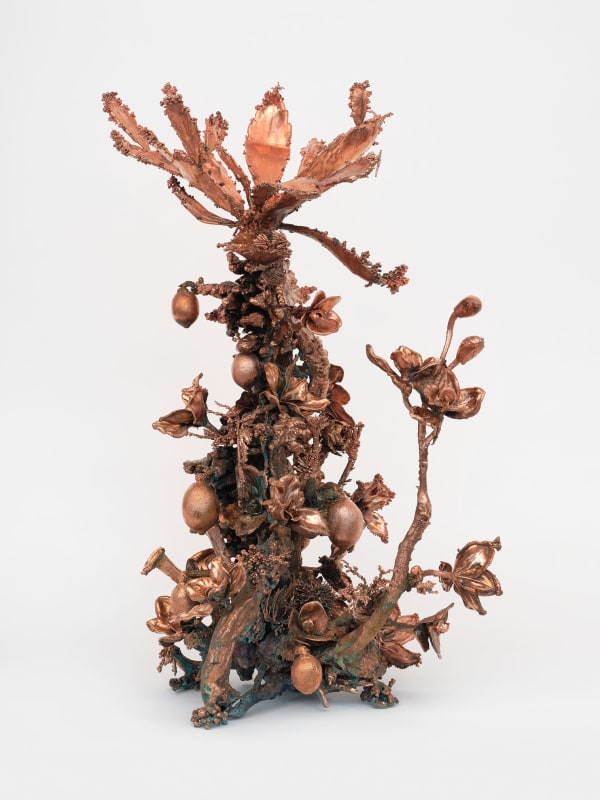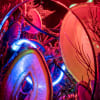Originally built in 1911, the 6.2-acre garden of retail giants Harry and Virginia Robinson of the Robinson Department Stores was developed over a period of 66 years and contains six distinct gardens and microclimates. Harnessing the rich, fertile soil and favorable climate of the Los Angeles basin, the Robinsons and their botanist Mr. Rhoades initially engaged in a period of highly experimental and imaginative landscape design, resulting in a unique and improbable collection of rare and exotic plant specimens collected from all over the world. Beginning in the 1930s, however, the couple commissioned landscape architect Charles Gibbs Adams, who subsequently developed the gardens grounded in classical design principles.
The Robinsons’ varied interests and preferences over six decades has resulted in the largest variety of plants grown outdoors in the continental U.S. These include over 1,000 palm specimens in the King Palm Forest, the largest stand of King Palms outside of Queensland, Australia; the largest Coral Tree in the State of California, conspicuously placed in the Italian Terrace Garden nearby an extremely rare female Ginkgo; and two rare cycads framed by rows of Mediterranean cypress trees on the Great Lawn.
Inspired by the diverse plant life and microclimates that miraculously thrive in such close proximity to each other at the Virginia Robinson Gardens, Los Angeles-based artist Max Hooper Schneider has responded to the site with a series of sculptural and environmental interventions throughout the gardens and estate structures. For Hooper Schneider, the Robinson Gardens mimics the unique ecological, cultural, and urban landscapes of Southern California in which human and nonhuman forces, both natural and artificial, constantly collide, coalesce, hybridize, repel, and evolve.
Over the course of multiple visits during the spring and summer, Hooper Schneider accumulated a collection of discarded organic material from the Robinson Gardens such as fallen branches, flowers, leaves, and roots. These various natural materials were then assembled into complex, intricate, and elegant compositions that render each individual component indiscernible from the other, further veiled by a mist of silver nitrate. In order to preserve these arrangements of organic material eternally, however, Hooper Schneider employs an alchemical process of metallic transmutation called electroplating.
Electroplating, first developed in the first half of the 19th century for use in the decorative arts and large-scale manufacturing, is an electrochemical process for producing a metal coating on an object’s surface. As such, Hooper Schneider places his silver nitrate-covered bouquets, which act as a cathode, alongside a copper metal anode, connecting to two via a battery and submerging them both in a bath containing copper sulfate, sulfuric acid, and chloride. Once submerged, Hooper Schneider then applies a current to the bath, which forces copper ions to travel across and deposit themselves onto the sculpture’s surface.
Traditionally, the electroplating process ends once the submerged object is uniformly and completely covered. Unsatisfied with the conventional results of this electrochemistry, however, Hooper Schneider continues to apply significant charge to the bath, accelerating the deposition of copper onto the sculpture which results in dendrite-like calcifications on these intricate sculptures that the artist calls Bonsai. In addition to the presentation of copper-plated Bonsai on display in the interior structures of the estate, Hooper Schneider has produced new outdoor sculptures on display throughout the gardens. These new sculptures, which contain bronze and nickel plating, are called Grotesques, referring to the carved stone figures that often adorn gardens as landscape design elements.
The sculptures, with their improbable bouquets of plants, flowers, fruits and vegetables, mimic the fantastical nature of the Robinson gardens where Mediterranean plants live in proximity to Tropical Oceana, and where citruses, magnolias, azaleas, camelias, gardenias, cycads, roses, gingers, bananas, and plumerias all harmoniously share space and atmosphere. Hooper Schneider’s sculptures are miniature versions of this composed landscape, but overgrown, uncontrolled, and unmanicured, their exotic and erotic nature is heightened. Upon closer inspection, we may discern various materials from the garden: persimmon buds, magnolia seed pods, fronds of saw palmetto, dragon tree fruit pods, Haworth’s aeonium, acanthus, red valerian flowers, bird of paradise, all seamlessly conjoined by their appendages and limbs.
Inspired by the collection of rare and exotic plants which were collected by the Robinsons and their botanist, Hooper Schneider has also been meticulously accumulating an inventory of rare, naturally black plants over the last several months. The nature of the plants, specifically as to how and why they have evolved to contain black pigmentation, remains a mystery despite several scientific attempts to explain this phenomenon. Scientifically speaking, black pigmentation in leaves would impede the absorption of light, photosynthesis, and growth in a plant. But it could also prove to be beneficial to a plant’s survival and evolution under adverse ecological conditions, such as excess light and UVB rays caused by the deterioration of the Earth’s ozone layer. As we confront ecological disaster and global warming, largely caused by human activity, Hooper Schneider’s display of black plants forces us to imagine a world where only these plants remain.
Hooper Schneider’s practice is fundamentally placed at the intersection of art, landscape architecture, and biology, often using scientific data and methods, as well as the nonhuman world, as a way to visualize and experience the world around us. These experiences are then synthesized into art works that present an alternative reality–one that challenges humans in their position of centrality. To be clear, however, Hooper Schneider does not see his practice as representations of the post-human or post-apocalyptic world, but rather possibilities of human, non-human, artificial, and natural interaction in which a human narrative does not dominate. Science, for Hooper Schneider, is not an occupation but rather a medium.
Max Hooper Schneider (b. 1982, Los Angeles, CA) received his Master’s degree in Landscape Architecture from Harvard Graduate School of Design and his Bachelor’s degrees in Urban Design and Biology from New York University, with additional studies in Marine Biology and Entomology at the University of Hawaiʻi at Mānoa and Santa Monica College. Selected solo exhibitions include UCCA Dune, Beidaihe, China (2024); François Ghebaly, Los Angeles, CA (2023); MO.CO Montpellier Musée Contemporain, Montpellier, France (2022); Hammer Museum, Los Angeles, CA (2019); and Del Vaz Projects, Los Angeles, CA (2021, 2014). His work was included in group presentations at the 15th Gwangju Biennale, Korea (2024); Hauser & Wirth, Los Angeles, CA (2023); the Centre Pompidou-Metz, France (2022); Schinkel Pavillon, Berlin, Germany (2021); Leeum Museum of Art, Seoul, Korea (2021), Kistefos Museum, Jevnaker, Norway (2021), the Belgrade Biennale, Serbia (2021); Regen Projects, Los Angeles, CA (2021); Marc Selwyn Fine Art, Los Angeles, CA (2021); the 16th Istanbul Biennial, Turkey (2019); Musée d’Art Moderne de Paris, France (2019); the 13th Baltic Triennial, Lithuania (2018); UCCA Beijing, China (2017); High Line, New York, NY (2017); Gagosian, Los Angeles, CA (2015); and Del Vaz Projects, Los Angeles, CA (2014).
Del Vaz Projects is a non-profit art space based in Los Angeles, California. Founded in 2014 by Jay Ezra Nayssan in a home-turned-installation space in Santa Monica—and accredited as a 501(c)(3) in 2021—Del Vaz Projects mounts exhibitions, produces publications, and stages programs centering visual art, performance work, and moving-image media. Named after the Persian phrase دست و دلباز (dæst ō del bāz), meaning openhanded and openhearted, our approach is intentional, relational, and resourceful. We collaborate with artists across generations and geographies to manifest projects in our space and throughout our city’s cultural and historical institutions—with each endeavor, infusing diverse environments with a sense of collective intimacy, intellectual inquiry, and expressive invention.
Our space serves as an incubator for artists, archives, and estates and is driven by four essential initiatives: a curatorial platform that produces on-site and off-site exhibitions that are free and accessible to the public; a research collective comprised of fellows and freelancers who pair cutting-edge scholarship with experimental authorship to craft insightful texts for Del Vaz Projects’ shows and publications; an independent press that designs, publishes, and distributes artist books and exhibition catalogs—featuring critical texts commissioned by contemporary writers and cultural innovators; and an artist production fund that secures fiscal and material resources through our extended community of collaborators in order to support underfunded artists as they pursue ambitious projects.
 Max Hooper Schneider, Dendrite Bonsai (Orange Tree), 2024
Max Hooper Schneider, Dendrite Bonsai (Orange Tree), 2024 Max Hooper Schneider, Erotic Wellspring Within the Void (Black Plant Garden), 2024
Max Hooper Schneider, Erotic Wellspring Within the Void (Black Plant Garden), 2024 Max Hooper Schneider, Dendrite Bonsai (Apple Tree), 2024
Max Hooper Schneider, Dendrite Bonsai (Apple Tree), 2024 Max Hooper Schneider, Dendrite Grotesque (Orchid and Cactus), 2024
Max Hooper Schneider, Dendrite Grotesque (Orchid and Cactus), 2024 Max Hooper Schneider, Dendrite Grotesque (Rose and Magnolia), 2024
Max Hooper Schneider, Dendrite Grotesque (Rose and Magnolia), 2024 Max Hooper Schneider, Dendrite Bonsai (Lily and Tennis Ball), 2024
Max Hooper Schneider, Dendrite Bonsai (Lily and Tennis Ball), 2024 Max Hooper Schneider, Dendrite Bonsai (Banana), 2023
Max Hooper Schneider, Dendrite Bonsai (Banana), 2023 Max Hooper Schneider, Dendrite Bonsai (Flowering Air Plants), 2023
Max Hooper Schneider, Dendrite Bonsai (Flowering Air Plants), 2023 Max Hooper Schneider, Dendrite Bonsai (Lemon), 2023
Max Hooper Schneider, Dendrite Bonsai (Lemon), 2023









